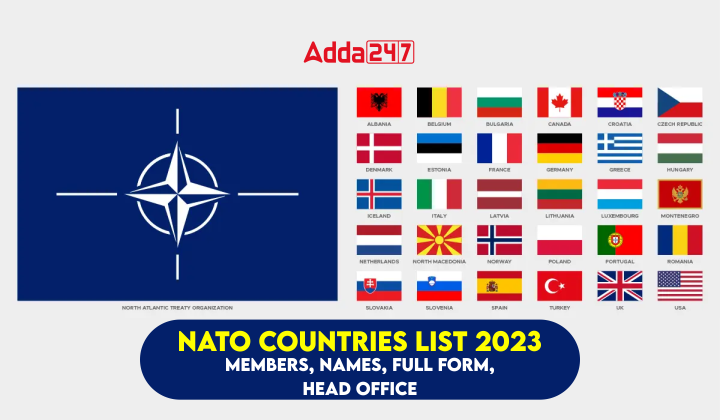What is NATO?
NATO, short for the North Atlantic Treaty Organization, continues to be a resolute and influential military alliance dedicated to the principles of collective defense and cooperation for security. Established in 1949 with the signing of the North Atlantic Treaty, its primary goals are to ensure the security and promote collaboration among its member states. Furthermore, NATO uploads democratic values, individual liberty and the rule of law. In this article, we will provide an up-to-date list of NATO member countries in 2023, along with a brief overview of NATO’s acronym, its functions and its headquarters.
NATO Full Form
NATO stands for the North Atlantic Treaty Organization. This name aptly reflects the organization’s origins and its core mission of ensuring security and cooperation among nations bordering the North Atlantic Ocean. NATO serves as a forum for member countries to consult and collaborate on security-related matters, emphasizing the values of democracy, individual liberty and the rule of law.
NATO Headquarter
NATO’s headquarters is located in Brussels, Belgium. This central hub serves as the administrative and decision-making center for the alliance, where member countries come together to discuss and coordinate various aspects of NATO’s mission, including collective defence, crisis management and cooperative security efforts.
NATO Countries and Members in 2023
As of 2023, NATO consists of 31 member countries spanning across North America and Europe. These nations have forged a collective commitment to mutual defence and security, fostering cooperation in military, political and strategic realms.
Here is the list of NATO member countries for 2023:
| NATO Countries List 2023 | |
| NATO Country | Capital City |
| Albania | Tirana |
| Belgium | Brussels |
| Bulgaria | Sofia |
| Canada | Ottawa |
| Croatia | Zagreb |
| Czechia | Prague |
| Denmark | Copenhagen |
| Estonia | Tallinn |
| Finland | Helsinki |
| France | Paris |
| Germany | Berlin |
| Greece | Athens |
| Hungary | Budapest |
| Iceland | Reykjavik |
| Italy | Rome |
| Latvia | Riga |
| Lithuania | Vilnius |
| Luxembourg | Luxembourg |
| Montenegro | Podgorica |
| Netherlands | Amsterdam |
| North Macedonia | Skopje |
| Norway | Oslo |
| Poland | Warsaw |
| Portugal | Lisbon |
| Romania | Bucharest |
| Slovakia | Bratislava |
| Slovenia | Ljubljana |
| Spain | Madrid |
| The United Kingdom | London |
| The United States | Washington D.C. |
| Turkiye | Ankara |
NATO: Geographical Distribution
NATO’s member countries are strategically distributed across both North America and Europe, establishing a robust transatlantic alliance that serves as a linchpin for regional security and stability. This partnership involves vital contribution from North American nations like the United States and Canada, as well as active participation from European countries, all collaborating in collective defence endeavors.
NATO’s Core Objectives
NATO’s objectives can be broadly categorized into political and military dimensions.
- Political Dimensions
- NATO encourages its members to uphold democratic principles, tolerance and diversity.
- NATO provides a platform for members to consult and work together on defence and security-related matters to minimize conflicts and build trust.
- Military Dimensions
- NATO is committed to peaceful dispute resolution but maintains military capabilities for crisis management operations. These operations can be conducted under Article 5 of the Washington Treaty or under a United Nations mandate.
- NATO’s principle of collective defence ensures that an attack on one member is considered an attack on all, fostering a strong deterrent against aggression.
Find More General Studies News Here





 Which City is known as the City of Bambo...
Which City is known as the City of Bambo...
 Who was the First Prime Minister of Indi...
Who was the First Prime Minister of Indi...







